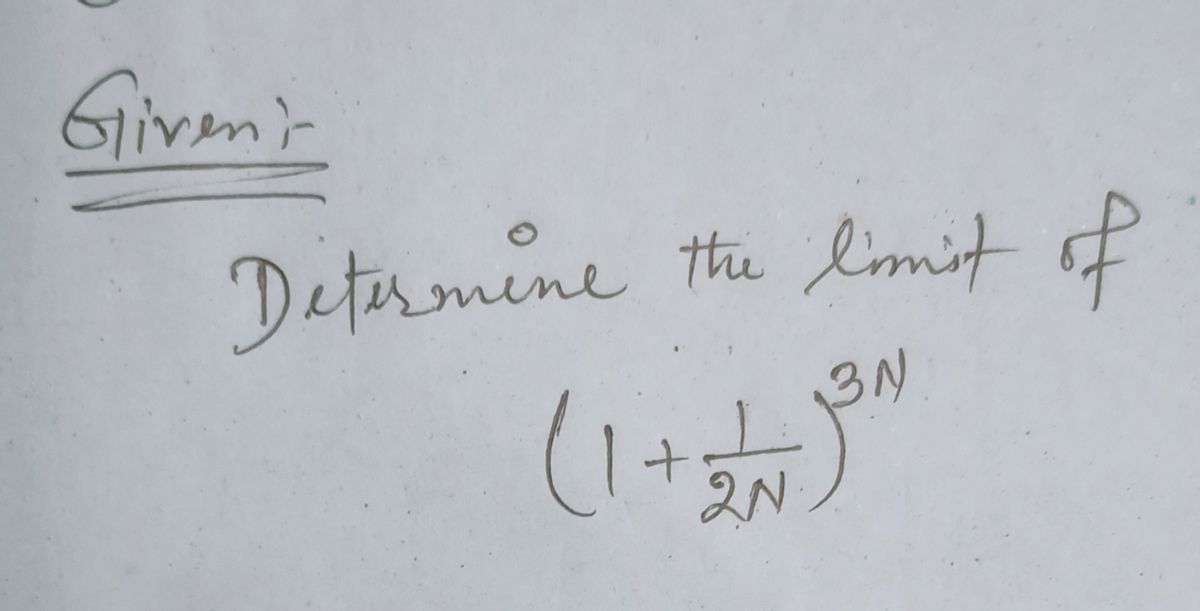Calculus: Early Transcendentals
8th Edition
ISBN:9781285741550
Author:James Stewart
Publisher:James Stewart
Chapter1: Functions And Models
Section: Chapter Questions
Problem 1RCC: (a) What is a function? What are its domain and range? (b) What is the graph of a function? (c) How...
Related questions
Question
![# Calculating Limits
**Objective:** Determine the limit of the expression as \( N \) approaches infinity.
### Expression:
\[
\left(1 + \frac{1}{2N}\right)^{3N}
\]
### Explanation:
The expression given represents a form that closely resembles the exponential limit definition, which can be related to the well-known mathematical constant \( e \).
**Steps to Solve:**
1. Identify the base expression:
\[
\left(1 + \frac{1}{2N}\right)^{2N}
\]
2. Recognize it as a variant of the limit definition for \( e \):
\[
\lim_{N \to \infty} \left(1 + \frac{x}{N}\right)^{N} = e^x
\]
Setting \( x = \frac{1}{2} \), we find:
\[
\lim_{N \to \infty} \left(1 + \frac{1}{2N}\right)^{2N} = e^{1/2} = \sqrt{e}
\]
3. Adjust for the exponent:
\[
\left( \left(1 + \frac{1}{2N}\right)^{2N} \right)^{3/2} = \left(e^{1/2}\right)^{3/2} = e^{3/4}
\]
### Conclusion:
The limit of the expression as \( N \to \infty \) is \( e^{3/2} \).](/v2/_next/image?url=https%3A%2F%2Fcontent.bartleby.com%2Fqna-images%2Fquestion%2Fe57a7d70-87de-4a1f-8104-5b2578062c6c%2F7540680d-fb8b-4b46-ae45-0d37ae0d05ab%2Fu8wx1f4_processed.jpeg&w=3840&q=75)
Transcribed Image Text:# Calculating Limits
**Objective:** Determine the limit of the expression as \( N \) approaches infinity.
### Expression:
\[
\left(1 + \frac{1}{2N}\right)^{3N}
\]
### Explanation:
The expression given represents a form that closely resembles the exponential limit definition, which can be related to the well-known mathematical constant \( e \).
**Steps to Solve:**
1. Identify the base expression:
\[
\left(1 + \frac{1}{2N}\right)^{2N}
\]
2. Recognize it as a variant of the limit definition for \( e \):
\[
\lim_{N \to \infty} \left(1 + \frac{x}{N}\right)^{N} = e^x
\]
Setting \( x = \frac{1}{2} \), we find:
\[
\lim_{N \to \infty} \left(1 + \frac{1}{2N}\right)^{2N} = e^{1/2} = \sqrt{e}
\]
3. Adjust for the exponent:
\[
\left( \left(1 + \frac{1}{2N}\right)^{2N} \right)^{3/2} = \left(e^{1/2}\right)^{3/2} = e^{3/4}
\]
### Conclusion:
The limit of the expression as \( N \to \infty \) is \( e^{3/2} \).
Expert Solution
Step 1: Given

Step by step
Solved in 3 steps with 2 images

Follow-up Questions
Read through expert solutions to related follow-up questions below.
Follow-up Question
Why/How did you know to use the 2n when multiplying the power?
Solution
Recommended textbooks for you

Calculus: Early Transcendentals
Calculus
ISBN:
9781285741550
Author:
James Stewart
Publisher:
Cengage Learning

Thomas' Calculus (14th Edition)
Calculus
ISBN:
9780134438986
Author:
Joel R. Hass, Christopher E. Heil, Maurice D. Weir
Publisher:
PEARSON

Calculus: Early Transcendentals (3rd Edition)
Calculus
ISBN:
9780134763644
Author:
William L. Briggs, Lyle Cochran, Bernard Gillett, Eric Schulz
Publisher:
PEARSON

Calculus: Early Transcendentals
Calculus
ISBN:
9781285741550
Author:
James Stewart
Publisher:
Cengage Learning

Thomas' Calculus (14th Edition)
Calculus
ISBN:
9780134438986
Author:
Joel R. Hass, Christopher E. Heil, Maurice D. Weir
Publisher:
PEARSON

Calculus: Early Transcendentals (3rd Edition)
Calculus
ISBN:
9780134763644
Author:
William L. Briggs, Lyle Cochran, Bernard Gillett, Eric Schulz
Publisher:
PEARSON

Calculus: Early Transcendentals
Calculus
ISBN:
9781319050740
Author:
Jon Rogawski, Colin Adams, Robert Franzosa
Publisher:
W. H. Freeman


Calculus: Early Transcendental Functions
Calculus
ISBN:
9781337552516
Author:
Ron Larson, Bruce H. Edwards
Publisher:
Cengage Learning